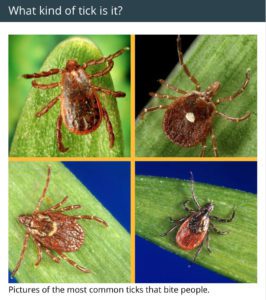TIME TO PREP YOUR YARD FOR ANOTHER TICK SEASON!
By Chris Williams on July 8, 2019.

Screen grab from https://www.cdc.gov/ticks/index.html
The Centers for Disease Control (CDC) has been emphasizing tick control as the number of tick-transmitted disease cases continues to grow (see Annual Tickborne Disease Update). CDC says the best approach is to landscape your property to establish tick-safe zones and to have a pest management professional treat high-risk areas bordering your yard.
CDC’S TICK-SAFE ZONES THROUGH LANDSCAPING
- Be aware of the parts of your property that are considered “tick zones” and stay out of them. This would be wooded and brushy areas where deer and rodents are common. These animals are secondary blood sources for ticks so where they live or travel, ticks will be common. Prime tick habitat is usually where your lawn ends and meets up with woods or unmaintained areas. Ticks love this woods/lawn border area.
- To further define this border area, beyond which is the dreaded tick zone, create a 3-foot wide barrier at the outer perimeter of your lawn. The barrier will remind children and others that they should not cross, while at the same time restricting tick migration into lawn areas. The barrier should ideally be of wood chips or gravel. Besides a lawn perimeter barrier, you can also create a barrier around patios and play equipment to keep ticks from moving into these areas. (P.S., this barrier looks great and will make your mowing easier, too.)
- Keep any woodpiles on the wood chip barrier, away from your home and stacked neatly in a dry area. This discourages mice and other rodents that the ticks feed on.
- Don’t locate playground equipment, decks, patios, or gardens near yard edges or trees. Avoid spending time too close to your 3-foot wood chip barrier. Keep play and leisure areas at least 9 feet away from the tick barrier and in a sunny location, if possible. Ticks avoid sun since it dries them out. Done right, this means you will have at least 12 feet (3 foot wood chip barrier + 9 foot lawn buffer) of protection between your fun and leisure zones and the tick zone!
- Beyond your 9 foot buffer area is your “tick-safe zone.” This is where your family can play and enjoy gardening and other daily activities (while wearing tick repellent), knowing you have done what you can to keep away from ticks. But, you still need to do tick checks whenever anyone has spent time outside near tick zones (see An Attached Tick! How to Remove it the Right Way).
- Continue to do what you can to make your property less attractive to ticks, mice and other small rodents, and deer:
- Mow the lawn and weeds frequently and keep leaves raked.
- Clear tall grasses and brush around your home and at the edge of your lawn.
- Manage garbage, bird feeders, pet and livestock feed, and garden produce so that you are not attracting and feeding rodents.
- Clean up stacks or piles of rocks, boards, bricks, trash, and other materials that could provide hiding and nesting places for rodents.
- Keep stored materials away from the house and outside of your protective barriers.
- Plant deer-resistant plants or install deer fencing.